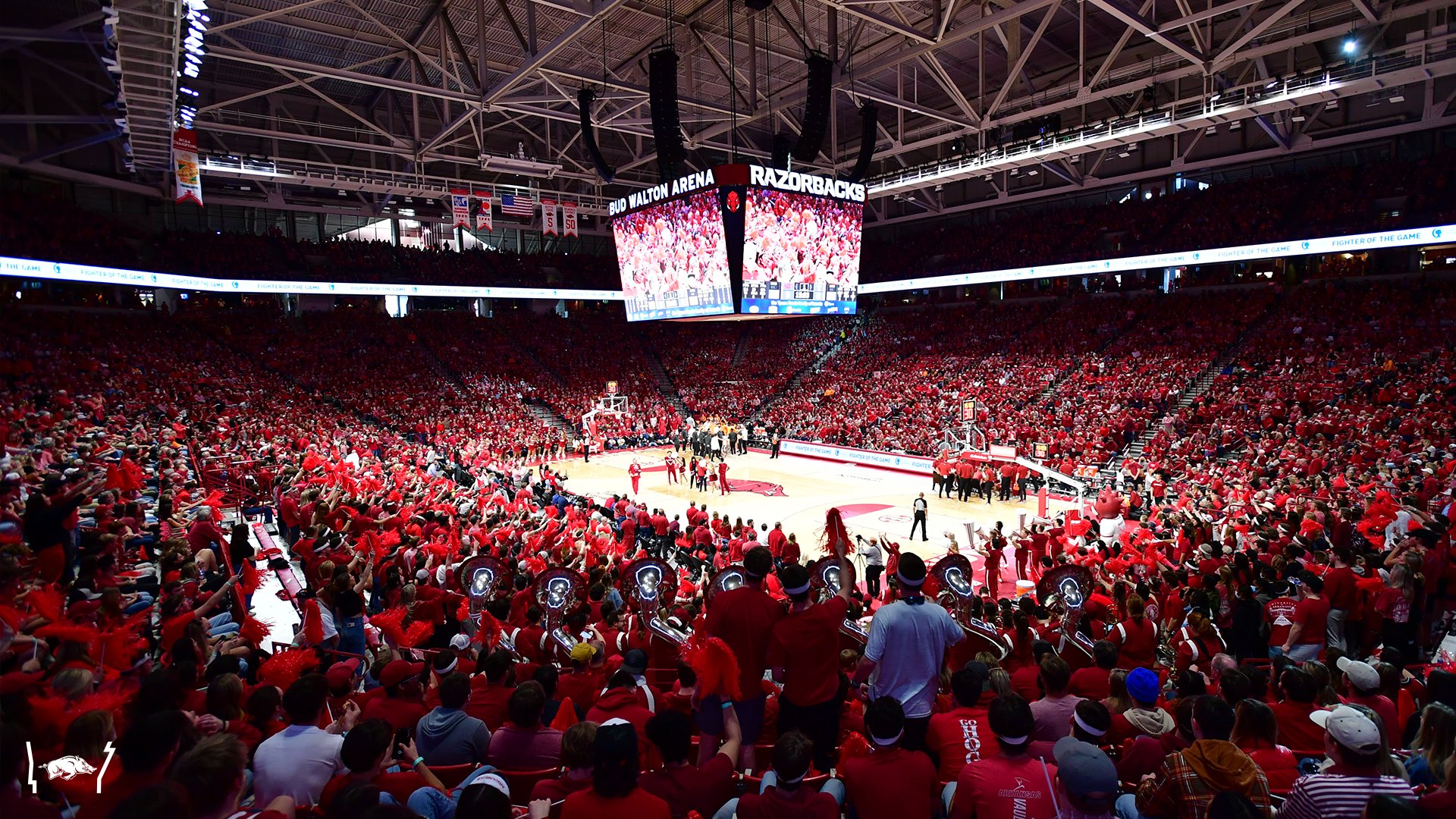Let’s Dance!
Arkansas is a 4-seed in the West regional. They’ll have to open tournament play against Vermont and then possibly UConn in Buffalo, New York — so not exactly a homefloor advantage for the highest-seeded team in this pod.
Vermont has dominated the America East conference for years. Coach John Becker is making his fourth appearance in 11 seasons with the Catamounts. At 28-5 and with scary-good analytics numbers, Vermont has a lot in common with Colgate, Arkansas’ first-round opponent last year.
Meet the Catamounts
Confused? Check out the advanced stats glossary to learn more about the stats cited here.
For the second straight year, the Hogs have managed to draw a popular upset pick. Vermont would have been picked in many brackets no matter which 4-seed they drew. This game isn’t necessarily a bad matchup for the Hogs, but it will be difficult simply because Vermont is pretty good. The analytics love them.
As always, our two models make picks. The matchup model constructs a predicted box score based on team stats, while the traditional model uses each team’s adjusted efficiencies and adds a momentum factor.
- Matchup Model: Vermont 73, Arkansas 70
- Traditional Model: Vermont 71, Arkansas 68
Thorough domination of weak opposition is actually useful for analysis… but it can’t be the only way to evaluate a team. That’s the issue with Vermont. Their strength of schedule is 304th out of 357 teams. They’ve played just two power conference teams: Maryland, who went 15-17 this season but beat the Catamounts 68-57 back in November; and Providence, the Big East regular season champs, who beat Vermont 68-58. Vermont also drilled Northern Iowa, who gave the Hogs a scare in Fayetteville.
Team Profile

That Texas A&M game tanked Arkansas’ 4-game grade, which was in the 80s. Vermont seems to be peaking: they graded at 99 in all three America East playoff games, which is insane. They beat NJIT 98-59, Binghamton 74-42, and UMBC 82-43. That’s gross. They’ve graded below 70 just four times in conference play.
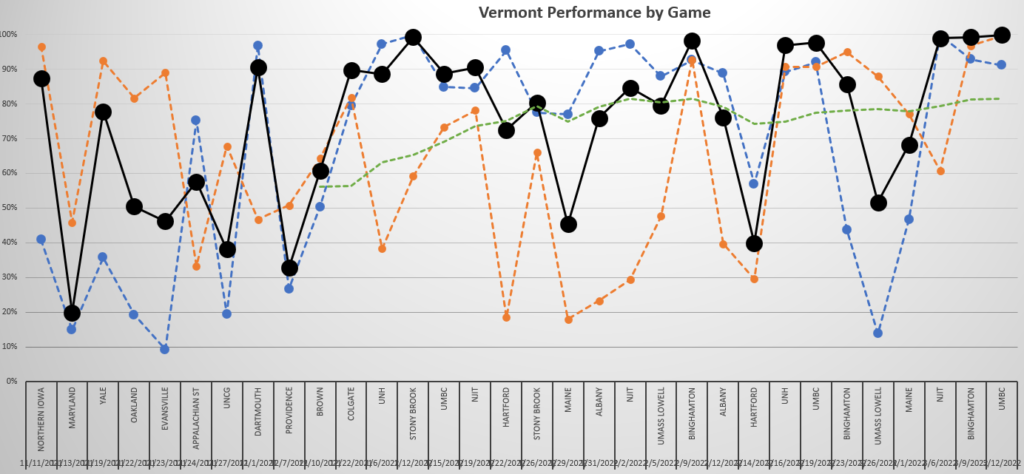
The black line is overall, blue is offense, orange is defense, and the green line is a moving 10-game average. You can see that they suffered a midseason swoon on defense before recovering, but what jumps out to me is how every decent non-conference team they played shut down their offense. Their offense graded at 41 against Northern Iowa, but Maryland, Oakland, Evansville, UNCG, and Providence all held them under 30.
We’ll get into their offense soon, but the Catamounts are a jump shooting team. If the shots aren’t falling, they have no other options on offense. That will have to be focus for the Hogs.
Personnel Profile

Power forward Ryan Davis is 6’8 and is Vermont’s tallest starter. Those four shooting guards that follow are 6’0, 6’2, 6’3, and 6’4. Nick Fiorillo and Isaiah Powell are 6’6 and 6’7, respectively. So there’s not much height here, and there’s a pretty significant production dropoff if the Catamounts have to go to their taller guys.
So which guy is the 3-point threat? All of them. Every Vermont player on this list (it’s top 8 by minutes played) takes a least one-quarter of their field goals from beyond the arc. Aaron Deloney, Finn Sullivan, and Nick Fiorillo all take more than half of their shots from downtown.
So which guy is the point guard? All of them. Every Vermont player on this list assists on at least 10% of made field goals while they are on the floor. Ben Shungu is the leader at 16%.
Davis, Shungu, and Deloney are the highest-usage guys, with all others playing mostly complementary roles: Sullivan as the 3-point sniper, Justin Mazzulla as the combo/interior guard, and Fiorillo and Powell as added height.
When Vermont has the ball

The Catamounts are a jump shooting team, so they take a lot of 3-pointers, but don’t draw many fouls or get offensive rebounds. You’ll see why in the clips below. They are solid but not overwhelming as a 3-point shooting team, but they use the high volume to space their opponents and get open 2-point shots, so they rank 6th in the country there. Arkansas has been great at defending 2’s during the entire second half of the season, but both Tennessee and Texas A&M bombed 3’s on the Hogs.
As you might expect from their roster, the Catamounts mostly play with 4- and 5-out looks without a traditional post presence. They are a ball screen team and will use screens to initiate their offense. Here, Davis sets a screen and is available for a pick-and-pop:
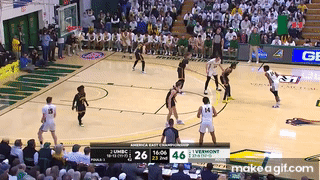
My favorite part about this is the lanky UMBC defender who was clearly supposed to switch but didn’t dejectedly slumping his shoulders as the shot goes up.
Using Davis as a high ball screener is common for the Catamounts. Here, just standing still after a handoff creates a driving lane:

If you wondering about the quality of the defense here, you’re onto something. Both of these plays are defended terribly by UMBC and that’s largely why they worked. A lot of concepts that dominated the America East conference are no match for the Razorback defense.
That said, Vermont still has some good stuff in its toolbox. Probably the most devastating is this 5-out basket cut:
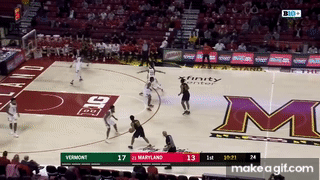
Vermont is a veteran team and they run their offense with incredible crispness. This looks like a freeflowing play, not a set call: watch the cutter break after he realizes his defender is too far to his outside.
Of course, against more athletic defenses, a well-timed cut isn’t always enough to get a bucket:
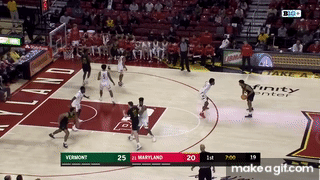
Maryland blocked six shots and held Vermont to just 14 of 38 inside the arc.
Hopefully, this quick look gives you an idea of the perspective behind the Catamounts’ great offensive numbers. But before you get too confident, remember, the ability to do this is very dangerous in March:
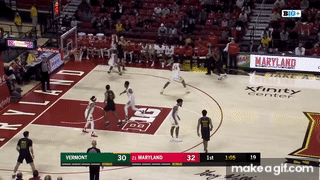
Vermont’s offensive success is overwhelmingly correlated to how well they shoot. Obviously that’s true for all teams, but it is especially true for Vermont. Here is a list of the stats that most highly correlate with offensive or defensive success for the Catamounts, in order of significance:
- Missed 3-pointer
- Assist on a made field goal
- Made 3-pointer
- Missed 2-pointer
- Made 2-pointer
Offensive rebounds, turnovers, free throws, pace, fouls drawn… not significant for Vermont. They will happily live and die by their shooting more than most other teams in the country.
Luck, then, will play a role here: if Vermont gets hot on contested 3-pointers, then you have to tip your cap to them. But Providence locked down the perimeter and Maryland locked down the interior and both escaped without much damage from the Vermont offense.
One last note: pace will be an interesting thing to watch. Arkansas’ defense tends to move almost as fast as the offense: Hog defensive possessions average 16.9 seconds in length — 275th-slowest in the country. But longer defensive possessions correlate to better defensive performances for the Razorbacks this season. Vermont plays quite slow: 18.0 seconds per possession, good for 257th nationally. The Catamounts will fast break if they have numbers, but they often are comfortable working from slower halfcourt sets. That favors the Hogs.
When Arkansas has the ball

While the Catamount offense hasn’t been able to replicate its high production against major opponents, the defense might be able to hold its own. The Vermont D graded at 46 against Maryland and 51 against Providence. It was even good against some solid mid-majors like Yale, Oakland, and UNCG.
Vermont’s absurdly-good defensive rebounding rate seems suspicious given their lack of height. Maryland had 14 offensive rebounds but Providence had only seven. The Catamounts don’t pressure the ball, so they don’t force turnovers but the tradeoff is they rarely foul. That’s a big red flag given what we’ve talked about in the wake of the slow-whistle game against Texas A&M. If the officials swallow the whistle, that plays to Vermont’s preferred style and makes this matchup real dicey real quick.
The best way to attack Vermont is to go fast and take advantage of less-athletic Catamount defenders. Maryland struggled when forced into halfcourt sets but had some success attacking in transition:
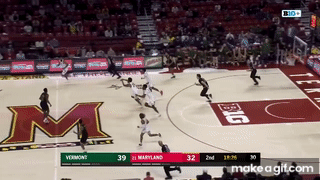
Obviously, this is how Arkansas broke the Colgate game open last year, so the playbook hasn’t really changed on these small Northeast schools. Vermont’s average defensive possession is 18.5 seconds — 17th-slowest in the nation — and they will be very uncomfortable if forced to go faster. The Catamounts haven’t seen anything like Arkansas’ blistering 16.2 seconds per possession (47th-fastest).
In the halfcourt, the Catamounts are primarily a man defense who rarely help on the ball in order to limit open jump shots. The lack of on-ball pressure suggests Vermont is bad against ball-dominant guards. That assumption would be correct: the Catamounts rank 213th in the nation in total game score by opposing point guards. Guards that can get to the rim in particular are their weakness, so this, ladies and gentlemen, is a JD Notae game. Maryland point guard Fatts Russell — a player very similar to Notae — and shooting guard Eric Ayala each had 22 points. Providence’s AJ Reeves had 24 points.
The America East team that gave Vermont the most trouble was Hartford. The Hawks went just 12-20 but dealt Vermont their only conference loss (75-74 in OT) and scored the most regulation points against the Catamounts in their other matchup, an 82-72 Vermont win. The Hawks’ 6’4 guard Austin Williams scored 34 points in the Hartford win and 24 points in the loss — his two highest-scoring games of the season. His +16.7 game score in the win is the best of his season and the best by any single player against Vermont this year.
Williams is different from other America East guards. He’s much more physical and doesn’t take a lot of 3-pointers. He simply used his superior strength and athleticism to bully Vermont defenders around the rim:
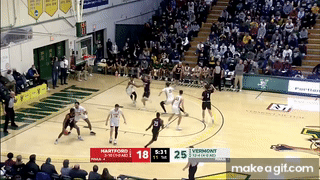
Hartford does a nice job of maintaining spacing to give Williams room to work. As Vermont is a man defense with no rim protector, they have no way to help the poor defender getting backed down here.
This is obviously how Arkansas is best suited to attack. Vermont plays with good positioning and will deny traditional entry passes, but they are very vulnerable to dribble penetration from athletic guards with good spacing.
Keys to the Game
#1 Attack the rim.
Arkansas’ shot selection to open last year’s Colgate game was awful. The Hogs settled for long jumpers as they fell behind until they finally figured out that they could use their athleticism and physicality to get to the rim. Every single bucket of the 17-0 run to close the first half against Colgate happened at the rim. Vermont is similar. The Catamounts play great team defense but have serious deficiencies in terms of height and all-around athleticism.
#2 Be disciplined on the perimeter.
The Catamounts will live and die by shooting, especially 3-point shooting. As every player Vermont puts on the floor is a 3-point threat, the Hogs will have to figure out how to protect guys like Jaylin Williams and Kamani Johnson who usually drop on ball screens. Arkansas’ defense is among the nation’s best at attacking ball screens, but Vermont’s tremendous ball movement will force Hog defenders to recover quickly.
#3 Smart play from Notae.
Unlike Arkansas’ last few opponents — LSU, Tennessee, and Texas A&M — the Catamounts don’t put much pressure on the ball. That means Notae (and Chris Lykes) will have lots of room to operate. Both guys have the ability to punish Vermont’s deficiencies, but bad turnovers or shot selection will set Arkansas back significantly.
The latest from Fayette Villains, straight to your inbox
Enter your email to subscribe and receive new post alerts and other updates. You can unsubscribe at any time.
